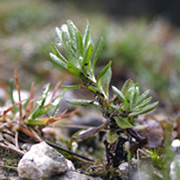UK: 2009 is a good vintage for Britain's rarest plants
01/09/09
The wild plant conservation charity, Plantlife, report that 2009 has been a great year for Britain's rarest plants.
It seems a combination of perfect weather conditions early in the year allied to conservation work being carried out up and down the country has contributed to one of the best years in recent memory for threatened plants.
"When we started working at these sites, the populations were facing a high risk of extinction," says Victoria Chester, Plantlife's Chief Executive.
Good weather in April, May and June set the summer growing season off to a good start, which doesn't seem to have been offset too much by the relatively wet July and August.
Chester continues: "This summer the results have been startling. We have a long way to go before safeguarding these lovely native species, such as Meadow Clary and Deptford Pink, but this is a great start. It shows that, with the right management in place, the fortunes of our most threatened flora can be reversed and they can begin to thrive."
Meadow Clary (Salvia pratensis) has shown a remarkable 1500 per cent increase across its 22 known sites in Britain and nearly 500 Deptford Pinks (Dianthus armeria) were found this year in Kent. Before management began in 2002 the numbers fluctuated between 25 and 60 in a handful of sites across the south-east of the country.
Deptford Pink / Dominic Price, Plantlife
Meadow Clary / Dominic Price, Plantlife
Other species that have seen a revival in 2009 include:
Marsh Clubmoss (Lycopodiella inundata), an unusual fern, found in heathland and bogs has benefitted from Plantlife management. In 2007 excavators were used to scrape away choking vegetation in the Thames Basin and two years down the line five new sites for the plant have emerged from long buried spores. Additional benefits of the work include the emergence of a host of other locally rare heath plants, such as sundews, as well as improving habitat for dragonflies and snipe.
One of the rarest natives of the botanically-rich Lizard peninsula in Cornwall is Pigmy Rush (Juncus pygmaeus). This unusual plant thrives in trackways and relies on disturbance for survival, but it has been in annual decline. However, in 2009 it appeared on sites where it hadn't been seen for 25 years giving tentative hope for the future. Other species that thrive in similar habitats have also increased including Pillwort (Pilularia globulifera) and Yellow Centaury (Cicendia filiformis).
 Broad-leaved Cudweed (Filago pyrimadata) has shown a 100 per cent increase on Plantlife's Ranscombe Farm reserve in Kent where there are now over 1000 individuals. This is good news for a plant that has been in serious decline for 60 years and is restricted to just six sites in the UK.
Broad-leaved Cudweed (Filago pyrimadata) has shown a 100 per cent increase on Plantlife's Ranscombe Farm reserve in Kent where there are now over 1000 individuals. This is good news for a plant that has been in serious decline for 60 years and is restricted to just six sites in the UK.
Broad-leaved Cudweed / Tim Wilkins, Plantlife